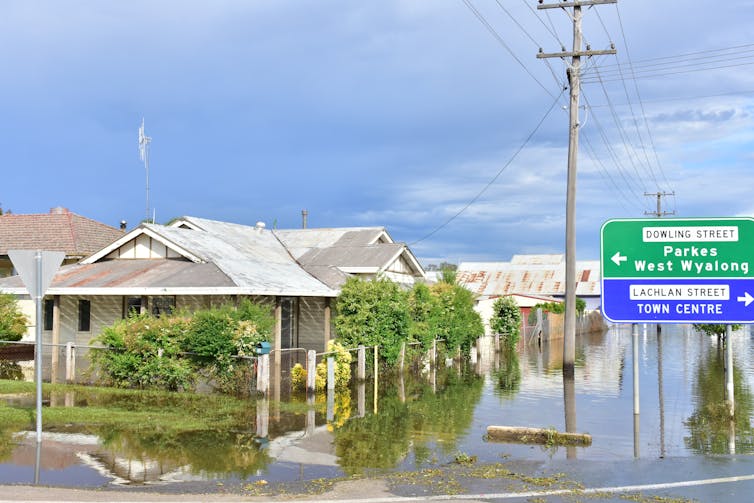Rebuilding homes after a disaster is an opportunity to build back better – why isn’t the insurance industry on board?

For many Australians, 2022 was a dark and devastating year. Major floods wreaked havoc on hundreds of communities in Queensland, New South Wales, Victoria and Tasmania. But for some, the floods themselves were only half the disaster.
As a recent report by Financial Counselling Victoria showed, many affected households had their insurance claims rejected or diminished, whether due to complicated exclusion clauses or because their “sum insured” had been whittled away by unexpected costs.
A long parliamentary inquiry sought to examine the insurance industry’s response to this disaster. Its final report – released to little fanfare last Friday – revealed a sector in crisis.
The report put forward 86 recommendations, which taken together could deliver real progress in pushing the insurance sector to deliver on its promises.
Some standout areas of focus included abolishing a principle called “like-for-like reinstatement” and increasing accountability and oversight. Making sure households can rely on their own coverage is a vital step.
But the report also highlighted just how vulnerable Australia’s housing stock is to climate change, which is no easy problem to solve.
Read more:
How extreme weather and costs of housing and insurance trap some households in a vicious cycle
Forced to repeat the same mistakes
To address the challenge of rising climate risk, we need to increase the resilience of Australian homes. Insurance will only be affordable if risk exposure can be brought down.
Recommendation 26 of the inquiry’s final report deals with the principle of “like-for-like reinstatement”. Written into many policies, this protects insurers from having to pay for home improvements in an insurance claim – known as “betterment” in insurance jargon.
‘Like-for-like’ rules can prevent households from improving their disaster resilience when rebuilding.
Anna Mente/Shutterstock
The underlying idea is to stop households sneaking an extra en-suite bathroom into their insurer-funded rebuild. The same dimensions and building materials have to be used.
But this can mean a home that has been flooded ends up being rebuilt with exactly the same flood risk.
This was the experience of Madeleine Serle, whose home was flooded in Melbourne in 2022. She told me she had asked her insurer to rebuild using polished concrete floors in the downstairs rooms of her home, instead of the plasterboard and wood that had soaked up the floodwaters. Serle reasoned that if it flooded again, it wouldn’t cause so much damage.
Her insurer refused. Even when Serle offered to pay any extra costs herself that might arise from concrete flooring, her insurer insisted on a “like-for-like reinstatement”. This meant using the same low-resilience materials that will likely be destroyed if inundated again by floodwater.
Bringing ‘betterment’ to the fore
Serle was actively trying to reduce her future flood risk, but this was precluded by the terms of her insurance contract.
By seeking an end to like-for-like reinstatement, recommendation 26 is pushing for “betterment” to be brought to the forefront of how we think about insurer rebuilds.
It proposes allowing households to swap out size for quality in an insurer rebuild. That could allow them to use the money saved from reducing the footprint of their home on resilience measures, which are often much more expensive.
This wouldn’t just reduce their exposure to climate risks – fire, flooding and so on. It could also improve the energy efficiency of our houses, which is another key part of the climate challenge in Australia.

The report highlighted an opportunity to bring ‘betterment’ to the centre of how we think about insurance rebuilds.
Lucy Cambourn/AAP
Standardised products
Many of the report’s other recommendations centred on the better handling of claims and better outcomes for households.
This includes by strengthening accountability through stronger regulatory oversight (recommendations 2, 4, 9, 41, 47, 49), tightening up some key loopholes (recommendations 3, 10, 13), and penalising insurers for delays in the resolution of claims (recommendations 19 and 57).
It also laid out ways to improve communications between insurers and households (recommendations 6, 10, 24, 25, 28, 33), so people can better understand what they should expect from their insurer – and when their insurer might be falling short.
These proposed reforms aim to create more standardised insurance products across the industry. But they could have gone further. The report didn’t go as far as recommending a fully standardised insurance product that all insurers would have to offer.

Making insurance products more standardised could make them easier to compare.
DC Studio/Shutterstock
As the Financial Rights Legal Centre has argued, standardisation is vital to untangling the “confusopoly” that leaves households unable to make informed decisions about the merits of different policies on the market without reading reams of product disclosure statements.
Reform alone isn’t enough
The inquiry’s final report recommends the government buy back some of the riskiest homes (recommendation 81), alongside much stronger government support for households looking to mitigate their own risks.
But insurance reform alone isn’t enough to solve the problem that Australian households face in securing their housing amid worsening climate risk.
The bigger overarching problem faced by Australia is one of climate change mitigation and adaption. While our country is exposed to relatively high levels of climate risk, much of this risk is borne by individuals through home ownership.
With nearly half of all renter retirees living in poverty, Australians know owning their own home is a powerful way to secure their economic future. That’s why home ownership is referred to as part of the “third pillar” of the retirement income system (voluntary private savings), along with superannuation and the public pension.
Reforming our insurance system can make important strides in providing households with better tools to manage climate risk.
Only with stronger safety nets, and by grappling with risks at the societal level, can we counteract the extreme individualisation of climate risk that we experience here in Australia.
Read more:
Some New Zealand homes are becoming uninsurable because of natural disasters – but all may not be lost



